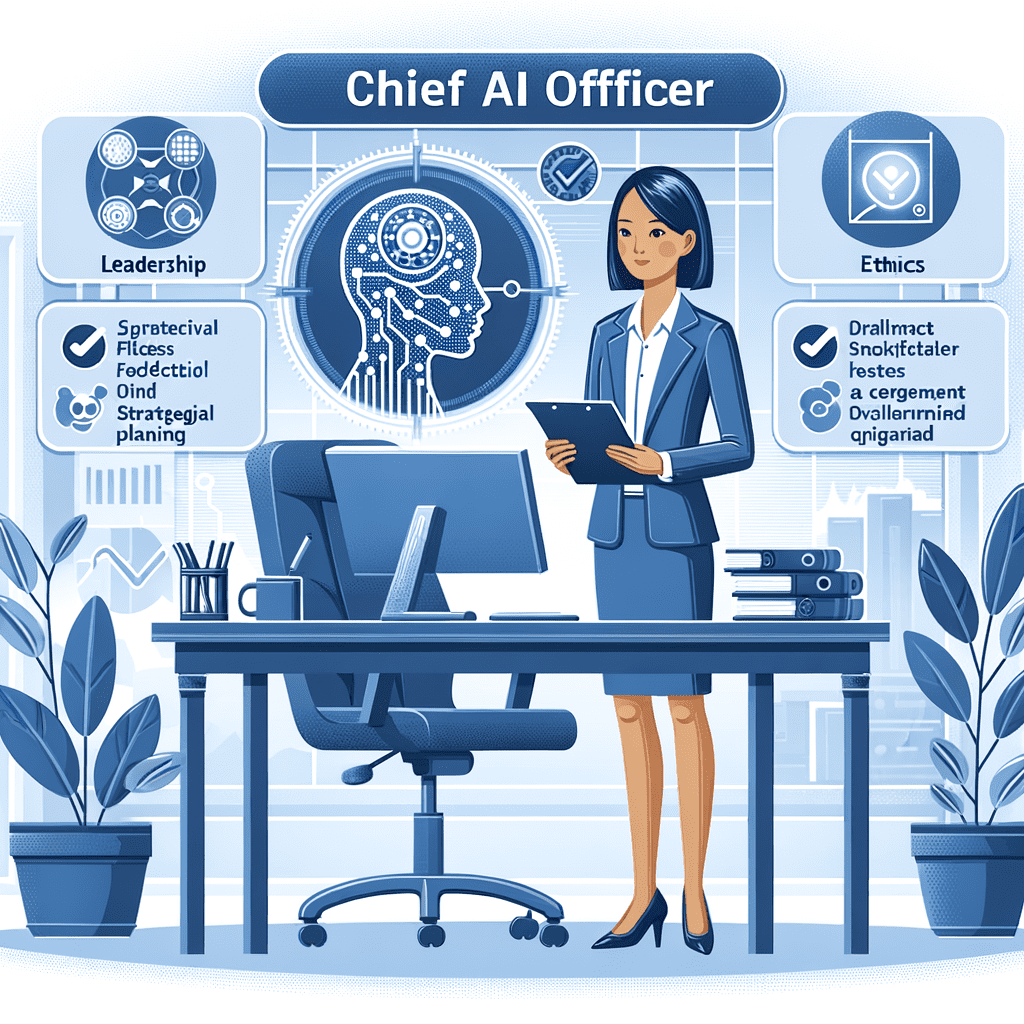Are you a small to mid-sized business owner looking to boost your employee well-being and productivity? In today’s business landscape, chief AI officers are increasingly important for driving AI innovation. This article explores the emerging role of the chief AI officer (CAIO), their responsibilities, required skills, and potential benefits they bring.
With AI’s growing impact, many companies view CAIOs as vital for success. This exploration will help you understand this role, its impact, and why a CAIO could be your company’s next strategic move. CAIOs are essential for maximizing the potential of AI technologies.
What is a Chief AI Officer?
A chief AI officer (CAIO) is an executive responsible for an organization’s AI strategy, AI initiatives, and implementation. This relatively new executive role has gained prominence due to the rise of AI, especially generative AI like ChatGPT.
The rising complexity of AI projects, involving multiple stakeholders, necessitates a dedicated leader. This need for guidance fueled the CAIO role’s growth. In the last five years, the number of CAIOs has nearly tripled, mirroring AI’s expanding influence on businesses.
President Biden’s 2023 executive order on artificial intelligence mandated that federal agencies appoint a chief artificial intelligence officer. These officers will oversee AI projects, ensuring responsible AI development, and act as key spokespeople. This mandate demonstrates the importance of AI governance and data privacy within government organizations.
The Expanding Role of Chief AI Officers
While CAIOs are a recent addition to organizational charts, their roles and responsibilities are evolving alongside business AI adoption. CAIOs contribute to enhancing customer experiences by identifying opportunities to use AI applications to improve them.
Strategic Leadership
A CAIO orchestrates an organization’s AI strategy, much like a conductor leads an orchestra. They develop a focused AI strategy while collaborating across departments. This cross-functional collaboration ensures everyone works toward common AI goals, which might include leveraging AI for new revenue streams.
Technology Oversight
CAIOs stay informed about new AI technologies, including generative AI. They explore and implement these advancements. The goal is to improve operational efficiencies, enhance customer experiences, and support business growth.
Ethical Considerations
CAIOs address ethical implications surrounding AI, much like chief data officers. They ensure responsible AI development by setting ethical guidelines, ensuring compliance, and mitigating bias in data and AI models. CAIOs stay abreast of evolving ethical standards and AI governance frameworks. A significant portion of AI executives recognize the recent emergence of their roles, highlighting AI’s fast-paced evolution. They focus on using AI solutions responsibly while adhering to regulatory requirements.
Advocacy and Education
CAIOs’ duties extend beyond technology. They also communicate AI initiatives to external stakeholders, such as academic institutions. CAIOs educate colleagues and stakeholders on AI standards, compliance, policy, technical strategy, and operations. A recent analysis emphasizes the increasing need for executives with strong leadership skills and understanding of AI.
Essential Skills for Chief AI Officers
CAIOs must possess a blend of business acumen and technical expertise. This includes a strong business understanding and a grasp of technology. AI influences numerous areas today. The necessary skillset encompasses several key areas.
Technical Skills
CAIOs need a deep understanding of AI and machine learning, including data science, analytics, and algorithms. Software development knowledge is beneficial for overseeing technology decisions and AI project implementation. This involves managing data scientists, resources for AI models, and deploying these models in enterprise applications.
Strategic Vision
The CAIO role demands more than just technical skills. CAIOs define the company’s AI roadmap and align it with overall business objectives. They identify new opportunities to use AI for revenue generation. A strong ethical compass is crucial for ensuring responsible AI development and navigating regulatory requirements.
Leadership Abilities
Inspiring stakeholders, fostering AI talent within the organization, and driving adoption of new AI initiatives are crucial. Compensation for AI professionals is also significant.
- In 2023, data analytics and AI executives in the U.S. averaged $1.134 million, with some earning $2.6 million.
- Those in financial services often have higher base salaries, while tech roles often earn more overall due to incentives and equity.
If AI is central to your product, a CAIO helps leverage its full potential. They guide complex AI efforts, using data infrastructure to build powerful AI tools.
Do You Need a Chief AI Officer?
Not every company requires a CAIO. However, some organizations are leading the way with public AI compliance plans.
| Organization | Compliance Plan |
|---|---|
| Department of Health and Human Services | M-24-10 PLAN |
| Department of Housing and Urban Development | M-24-10 PLAN |
| Department of Transportation | M-24-10 PLAN |
| Department of Veterans Affairs | M-24-10 PLAN |
| National Aeronautics and Space Administration | M-24-10 PLAN |
| Office of Personnel Management | M-24-10 PLAN |
| U.S. Agency for International Development | M-24-10 PLAN |
| U.S. National Science Foundation | M-24-10 PLAN |
A 2023 survey revealed that only 11% of businesses currently have a CAIO. However, 21% are actively seeking one, indicating the growing recognition of this role. Articles by IBM and Forbes further explore this increasing demand.
FAQs about chief ai officers
What does a chief AI officer do?
A CAIO leads a company’s overall AI strategy. They oversee AI technology projects, ensuring alignment with business goals and promoting the use of responsible AI practices.
How much does a chief AI officer make?
CAIO salaries vary based on experience, company size, and location. In 2023, average total compensation was $1.134 million, reaching up to $2.6 million in some cases. Executive education and specialized experience with AI systems can also affect salary.
Who is the chief responsible AI officer?
The responsible AI officer can vary among organizations. They might report to the CEO, COO, CTO, or chief data officer, depending on the company structure.
Should you hire a chief AI officer?
Consider hiring a CAIO if AI is integral to your business strategy. If your AI projects are complex, or if you need leadership in AI adoption and ethics, a CAIO could be valuable.
Conclusion
Chief AI officers are strategic leaders driving AI adoption and innovation within organizations. As businesses increasingly leverage AI projects for financial services and customer experiences, CAIOs are essential for realizing AI’s potential. CAIOs are critical for navigating the complexities of digital transformation and AI integration.
Their responsibilities encompass establishing an AI strategic vision, overseeing AI projects and development, and ensuring responsible AI practices. CAIOs contribute to business growth by identifying opportunities, leveraging AI tools, and enhancing customer experiences. The importance and influence of chief AI officers are poised to grow even further.






